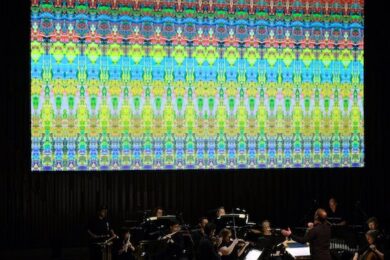Live photographs courtesy of Tom Howard/Barbican
The New York Times once called Steve Reich "our greatest living composer". John Adams and Philip Glass are also sometimes described in such a fashion but for me, Reich is the winner by a long stretch. The best of his compositions – The Desert Music, Octet, Tehillim, The Four Sections and Music For 18 Musicians – are incomparable works of beauty and optimism that offer the kind of transcendent experiences for the attentive listener that usually require faith or adherence to some form of mystical process.
Tonight’s concert at the Barbican features two pieces. Runner a short piece from 2016 that falls just short of 15 minutes, and the European premiere of Reich/Richter, a new 45-minute work with an accompanying film by Gerhard Richter and Corinna Belz. Richter, famous for both his abstract and photorealistic pieces, is often referred to as "the greatest living painter", and tonight’s meeting of two titans in their individual fields carries a buzz of excitement and expectation among crowds of both the early and late performances. When I arrive, Reich (who turned 83 on October 3) is sat signing CDs, with a lengthy line of admirers awaiting their turn. He does not, however, appear onstage until the very end of the performance.
Being unfamiliar with Runner, I spend much of its duration scribbling notes. Attempting to put this beautiful, ineffable music into words is no easy task. A piano pulses. Violins swell and flutes and vibraphone join in the wondrous resonating hum that forms a kind of total harmonic environment from out of which all the other melodic forms arise, ephemeral in their beauty before being subsumed and recast by the ever propulsive sonic mass.
I’ve asked myself this question before: how is it that an 83-year-old composer with no evident history of interest in mind-altering substances creates the most psychedelic music imaginable? The answer, I think, lies in the fact that Reich’s musical process taps into similar forms as those we find repeating in nature, created by the interaction of such mathematical processes as the Fibonacci sequence or Golden ratio. Yet far from being the dry, academic process that might imply, the evanescent forms that appear in Reich’s music are powerfully optimistic in a way that feels honest, unflinchingly brave and essentially human.
Take, for instance, William Carlos Williams text that inspired Desert Music: "Man has survived hitherto because he was too ignorant to know how to realise his wishes. Now that he can realise them, he must either change them or perish." The piece attains an incredible intensity of feeling by looking squarely at the possibility of mankind’s destruction by its own hand via the agency of nuclear weaponry, whilst offering a transcendent litany of music and human voices as an argument for its inherent value and desire to keep existing. Light, airy and organic in their touch, Reich’s compositions map out a similar process to the psychedelic experience. The loss of ego, the temporary nature of form. The joy of dissolving into the bigger picture and the trust in the process that sees form returning with myriad alterations over the progression of time.

At 15 minutes, Runner is a concentrated slice of Reich that packs a powerful impact. I’m left wondering how the main piece will compare after that, and whether my capacity to be amazed has already been reached. As the second part of the performance begins, lines of warm colour appear on the screen, yellow and pink, sunset like. The colours begin to migrate, thicker bands forming. A blurring in the centre transmutes into little points of detail that provide an odd sensation of refocusing the eye. Fractal-like details appear, then what Reich himself termed ‘creatures’ – symmetrical shapes with the semblance of limbs and features, constantly in flux – evolving, dissipating and reemerging in the sequence.
The film itself was produced by a process similar to Richter’s book, Patterns, but apparently in reverse. Richter scanned a photo of his original painting "into a computer, then cut the scan in half and took each half, cut that in half and two of the four quarters he reversed into mirror images". The process was then repeated. The overall visual effect (for those willing to submit to its hypnotism) is a kind of ultimate kaleidoscope – a hallucination engine that comes closer to evoking the effects of psychedelic drugs without their chemical agency, than anything else I’ve ever witnessed. Although during the most intense moments of the film, my attention seemed captured by the images rather than the music, the two aspects of the performance were clearly synergetic. Having spent the first part of the evening attempting to describe the way form arises, dissipates and reemerges in Reich’s music, I found it utterly exhilarating and consciousness altering being treated to the visual equivalent of that process in Richter and Belz’s film in the second part. For me, Reich’s music has always accessed the "cauldron of creative form", "god’s workshop", or whatever else you would like to call that realm, and tonight’s imagistic counterpart perfectly complemented that process.



